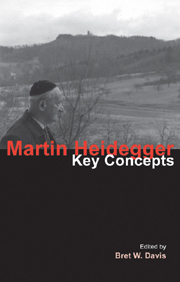Book contents
- Frontmatter
- Contents
- Contributors
- Acknowledgements
- Abbreviations
- Introduction: key concepts in Heidegger's thinking of being
- 1 Hermeneutics of facticity
- 2 Phenomenology: Heidegger after Husserl and the Greeks
- 3 Dasein as being-in-the-world
- 4 Care and authenticity
- 5 Being and time
- 6 The turn
- 7 Heidegger, National Socialism and the German People
- 8 Truth as alētheia and the clearing of beyng
- 9 The work of art
- 10 Ereignis: the event of appropriation
- 11 The history of being
- 12 Will and Gelassenheit
- 13 Ge-stell: enframing as the essence of technology
- 14 Language and poetry
- 15 The fourfold
- 16 Ontotheology and the question of god(s)
- 17 Heidegger on Christianity and divinity: a chronological compendium
- Chronology of Heidegger's life
- Bibliography
- Index
9 - The work of art
- Frontmatter
- Contents
- Contributors
- Acknowledgements
- Abbreviations
- Introduction: key concepts in Heidegger's thinking of being
- 1 Hermeneutics of facticity
- 2 Phenomenology: Heidegger after Husserl and the Greeks
- 3 Dasein as being-in-the-world
- 4 Care and authenticity
- 5 Being and time
- 6 The turn
- 7 Heidegger, National Socialism and the German People
- 8 Truth as alētheia and the clearing of beyng
- 9 The work of art
- 10 Ereignis: the event of appropriation
- 11 The history of being
- 12 Will and Gelassenheit
- 13 Ge-stell: enframing as the essence of technology
- 14 Language and poetry
- 15 The fourfold
- 16 Ontotheology and the question of god(s)
- 17 Heidegger on Christianity and divinity: a chronological compendium
- Chronology of Heidegger's life
- Bibliography
- Index
Summary
Overcoming aesthetics
Heidegger's writings on art carry out what he sees as the task of providing “a new content for the word ‘art’ and for what it intends to name” (IM 140). From the mid 1930s to the end of the 1950s Heidegger's work is shaped by a persistent engagement with art. Prior to this he writes nothing substantive on art, and barely mentions art in any publication or lecture. But the 1930s sees major works featuring sections dedicated to art, aesthetics and poetic language, to which lecture courses in 1936 (on Nietzsche), and in 1934, 1941 and 1942 (on Hölderlin), are also devoted, as are numerous essays throughout the 1940s and 1950s. “The Origin of the Work of Art”, begun in 1935 but not published in full until 1960 – in other words, it spans the whole of the period in question – is Heidegger's most sustained treatment of art, and it is that text that this chapter focuses on. “The Origin of the Work of Art” comprises three lectures, an Epilogue and an Addendum. It is important to note that the essay appeared in two distinct forms and at two separate times: as lectures before the war and in print after the war. Between the first oral version of 1935 and the first full published version of 1960 the text undergoes constant revision and clarification, and has significant sections added.
- Type
- Chapter
- Information
- Martin HeideggerKey Concepts, pp. 128 - 139Publisher: Acumen PublishingPrint publication year: 2009
- 1
- Cited by

